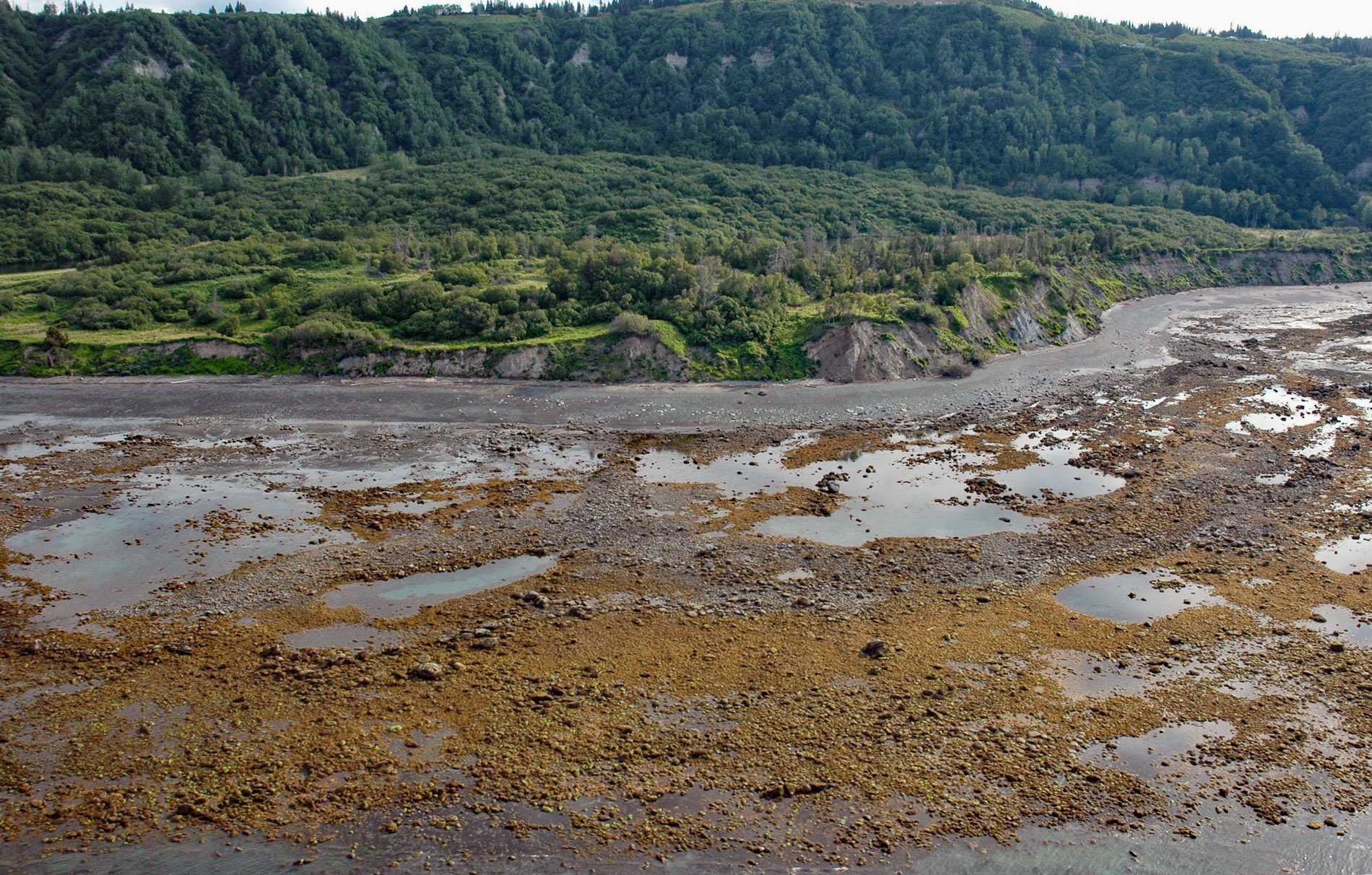Bluff Point is a conspicuous headland with a variable elevation between about 300 and 700 feet (100 to 215 m) on the western shore of the Kenai Peninsula in Cook Inlet near the north shore entrance to Kachemak Bay, about 12 miles (19 km) southeast of Anchor Point and 4 miles (6 km) west of Homer, Alaska. The headland was named in 1880 by William H. Dall of the U.S. Coast and Geodetic Survey. The Border Ranges fault is roughly aligned with the axis of Kachemak Bay and juxtaposes Mesozoic sedimentary rocks of the Peninsular terrane to the west forming the Kenai lowlands against highly deformed and metamorphosed Mesozoic rocks of the Chugach terrane to the east forming the Kenai Mountains. Bluff Point is composed of sedimentary rocks of the Beluga Formation that were deposited during the Miocene and then weakly lithified into layers of sandstone, siltstone, mudstone, shale, coal, and minor amounts of volcanic ash. The Beluga Formation on the Kenai Peninsula is up to 5,000 feet (1,525 m) thick and overlain by unconsolidated surficial sediments deposited as a direct or indirect consequence of glaciation or stream floodplains. The thickness of the surficial deposits varies from less than 3 feet (1 m) to more than 150 feet (50 m). Most of the western coastline of the Kenai Peninsula between Kenai and Homer is receding in response to wave erosion. This erosion has resulted in significant loss of property and the destruction of buildings or facilities constructed near the edge of the coastal bluff. Erosion is a serious problem, particularly where the bank is composed of weakly lithified or unconsolidated sediments. The present cycle of erosion apparently began after the 1964 Alaska earthquake when the western Kenai Peninsula subsided relative to sea level. Shoreline retreat will continue until beaches are sufficiently built up to protect sea cliffs from wave attack.
Extensive preparations for coal development in the Homer district were made from 1899 to 1902 by the Cook Inlet Coal Fields Company in the vicinity of Bidarki Creek about 2 miles (3 km) east of Bluff Point. This company built a large dock at the tip of Homer Spit and a 42-inch gauge railroad from the dock to Bidarki Creek. Underground work included excavating three tunnels into the coal bed in the beach bluff and the starting of two mining shafts a short distance back from the bluff. Despite the rather extensive development work, the total production by this company was apparently only a few hundred tons of low-grade sub-bituminous coal. According to records of the U.S. Geological Survey, the next coal-mining activity in the Homer district was in 1915, when operations were resumed at the same locality near Bidarki Creek on a permit granted under the new coal-leasing law enacted in 1914. This law provided for the granting of permits to mine coal in tracts of 10 acres (4 ha) or less. No records of production are available, except that in 1915 this operation, known as the Bluff Point mine, was the largest of several operating under similar permits that together produced about 1,400 tons of coal. Some production continued at the Bluff Point mine until 1923, the operation having been changed from a permit to a lease in 1920. Records show that about 1,200 tons were mined in 1921, 2,700 tons in 1922, and 700 tons in 1923. No records were found to indicate that the mine was operated between 1924 and 1945. In 1946, the Bluff Point mine was taken over by the Homer Coal Corporation. A new camp was constructed, and underground development started. Some development work and incidental coal production were continued until 1951, when an extensive engineering study, including the drilling of nine diamond-drill holes, was made in an effort to block out reserves of stripping coal. Since 1951, there was no production reported from this property. The total commercial production of coal in the Homer district is not known, but it probably does not exceed a few thousand tons. In addition, local residents have for many years used coal picked up on the beach or dug from convenient outcrops farther inland.
The Bluff Point headwall creates an enormous gap in the bluff, now carpeted with grassy meadows, dense alders and spruce, and four small ponds. This mile-wide chasm was made by a massive collapse of the bluff, called the Bluff Point Landslide, the result of a slump that occurred about 2,250 years ago, probably triggered by a major subduction zone earthquake. The landslide is the largest slope failure along the southwestern shore of the Kenai Peninsula and extends for 3.4 miles (5.5 km) in a northwest-southeast direction roughly parallel to the coastline. Depth soundings indicate that the body of the landslide, measured perpendicular to the coastline, was 1 to 1.2 miles (1.7 to 2.0 km) long. The composition of the deposit indicates that the landslide resulted from the failure of the moderately to weakly consolidated mudstone and sandstone of the Beluga Formation. The initial failure probably occurred when the Late Wisconsinan glacier that once filled Kachemak Bay receded leaving the slope unsupported. Subsequent slumping may have been caused by progressive wave erosion at the base of the high sea cliff and seismic shaking, although no additional slumps were identified following the 1964 Alaska earthquake. In July 2009, the high bluff face between Bluff Point and Diamond Creek collapsed onto the upper end of an old slide block, rotating the block and pushing up an unusual mound about 15 feet (4.5 m) high into the intertidal zone for a distance of 1200 feet (366 m) along the beach. Rotated shale layers in the mound center were nearly vertical. Over the following winter, the mound was completely removed by wave erosion. Read more here and here. Explore more of Bluff Point and Kachemak Bay here:

